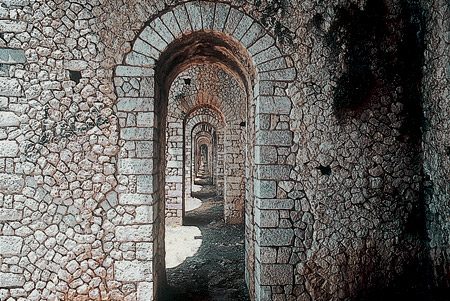






Zollverein School of Management and Design, Germany
The building is simply just a cube but what interests people is those tons of small square windows around the building. Those windows help with lighting as well as visual interest.

Midrand Water Tower, South Africa
It was designed as urban sculpture with a thought of functional and yet aesthetic structure. Capable of holding 6.5 megalitres, Southern hemisphere now have the largest water tower located in Midrand town, South Africa. The cone has 4 meters length in diameter stem with another 10 meters cube concrete base.
SPHERE

Dome of the Rock, Israel
It is the oldest existing Islamic building in the world located in Jerusalem, Israel. It is also known as the third sacred place for Muslims. The dome, or hemisphere, was widely used in Middle East to represent holy structures and as a place for worshipping and religious interactions.
CYLINDER

Faulx Les Tombes Castle, Belgium
The structure was built in 1872 by Hendrik Beyaert in a Gothic style. Big towers' shape is influenced by the primary form of cylindrical shape with an upside down cone on top of them.
PYRAMID

The pyramids of Menkaure, Khafre and Khufu, Egypt
The pyramidal shape was first invented by the Egyptians, as far from research, and mainly was constructed using stones. The shape consists of a square base with four subsided of triangle form, however, the steep of pyramids are vary.


The Parthenon is the most famous surviving building with the Doric order. It was built in the 5th century BCE to honor the Greek goddess Athena.
Ionic
Ionic column style looks more slender than Doric because the shafts are taller and the base are bulged out which made the column looks more straight. Comparing with Doric, Ionic column is more decorative with scrolls added to its capital. Also flutes, line carved on the column"s surface, were added to this style.
Ionic order

Example of Ionic columns in building
The temple of Athena Nike, Athens, Greece

It was he earliest fully ionic temple on the Acropolis where people used to worship the goddess in hope of the long war against the Spartans and their allies.
Corinthian
This style of column has highly ornate and is the most decorative and elegant fully with details, flowers and leaves, at its capital below the scroll. The column is also bulged out at its base making the column looks slender.
Corinthian order

Example of Corinthian columns in building
The Negaunee National Bank, Negaunee, Michigan

The state bank was constructed in 1912 after the old bank was destroyed by fire in the same year. The building hosted the Negaunee State Bank until the bank failed during the Great depression in 1933
over here, over there